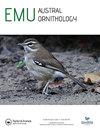Environmental effects on movement and breeding of Australasian Gannets: insights from banding records
IF 1.1
4区 生物学
Q3 ORNITHOLOGY
引用次数: 0
Abstract
ABSTRACT Banding has historically been the most efficient method of marking individuals to gather large datasets on bird movement, especially in seabirds which spend a large proportion of their life-cycle at sea. The Australian Bird and Bat Banding Scheme has gathered such long-term records, including for the Australasian Gannet (Morus serrator). Between 1954 and 2022, a total of 12,583 bands were deployed at seven breeding sites in Australia, of which 522 were recovered dead. An additional 325 individuals from four banding sites in New Zealand were recovered along the Australian coastline. The effects of broadscale environmental indices on movement (inferred from banding recoveries) during the post-breeding period were investigated at two colonies with the most banding effort (Pope’s Eye, Lawrence Rocks). Individuals >1 year old and those from Pope’s Eye were recovered closer to their banding site. There were negative effects of current-year Southern Oscillation Index (SOI) and 1-year lagged Southern Annular Mode (SAM) on recovery distances for Lawrence Rocks individuals, while 2-year lagged SAM positively and negatively affected recovery distance and direction, respectively, for Pope’s Eye individuals. The number of chicks banded (index of chick production) at Pope’s Eye was negatively influenced by 1-year lagged SAM and 2-year lagged SOI, while the likelihood of recoveries of first-year individuals was positively influenced by 1-year lagged SAM. The results of the present study revealed a potential effect of environmental conditions on post-breeding movement with seemingly contrasting effects between colonies, and on reproduction, highlighting the usefulness of long-term banding and recovery efforts.环境对澳大利亚塘鹅运动和繁殖的影响:来自放牧记录的见解
从历史上看,标记个体是收集鸟类运动大数据集的最有效方法,特别是对于那些在海洋中度过大部分生命周期的海鸟。澳大利亚鸟类和蝙蝠绑带计划收集了这样的长期记录,包括澳大利亚塘鹅(Morus serrator)。在1954年至2022年期间,在澳大利亚的七个繁殖地共部署了12583只带,其中522只被发现死亡。在澳大利亚海岸线上发现了另外325只来自新西兰四个栖息地的个体。在两个种群(Pope’s Eye, Lawrence Rocks)中,研究了大尺度环境指数对繁殖后种群运动的影响(从种群的条带恢复推断)。>1岁的个体和来自蒲柏之眼的个体在其结扎点附近被发现。南方涛动指数(SOI)和滞后1年的南方涛动模式(SAM)对Lawrence Rocks个体的恢复距离有负向影响,滞后2年的南方涛动模式对Pope’s Eye个体的恢复距离和恢复方向分别有正向和负向影响。1年滞后的SAM和2年滞后的SOI负向影响Pope’s Eye雏鸡的条带数(雏鸡产量指数),而1年滞后的SAM正向影响第一年个体的恢复可能性。本研究的结果揭示了环境条件对繁殖后迁移和繁殖的潜在影响,这些影响在种群之间似乎是截然不同的,强调了长期带带和恢复努力的有用性。
本文章由计算机程序翻译,如有差异,请以英文原文为准。
求助全文
约1分钟内获得全文
求助全文
来源期刊

Emu-Austral Ornithology
生物-鸟类学
CiteScore
2.00
自引率
7.70%
发文量
33
审稿时长
>12 weeks
期刊介绍:
Emu – Austral Ornithology is the premier journal for ornithological research and reviews related to the Southern Hemisphere and adjacent tropics. The journal has a long and proud tradition of publishing articles on many aspects of the biology of birds, particularly their conservation and management.
 求助内容:
求助内容: 应助结果提醒方式:
应助结果提醒方式:


